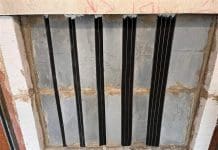New suggested standards for front doors to flats released in the wake of the Grenfell Tower tragedy for the first time bring security compliance into the refurbishment sector
The government has released its suggested standards for front doors to flats within multi-occupancy residential buildings following the Grenfell Tower fire in June 2017.
As well as making a number of recommendations about actions required to improve fire safety, they also serve to bring security compliance into the refurbishment sector for the first time.
In March 2018, the Metropolitan Police, as part of its criminal investigation into Grenfell, found that a glazed, composite fire door to a flat entrance, designed to resist fire for up to 30 minutes as required by the Building Regulations, had failed after approximately 15 minutes.
The government sought advice from its Independent Expert Panel, which was set up after the tragedy to advise on immediate measures needed to ensure building safety.
While concluding that the risks to public safety have not changed significantly and remain low, the Ministry of Housing, Communities & Local Government has drawn up a number of recommendations on the assurance and replacement of flat entrance fire doors, which are critical to most fire strategies to provide protection against fire and smoke.
Its recommendations to landlords and building owners include:
To arrange for all fire doors, including their closers, to be checked routinely or inspected by a suitably qualified professional.
To check that flat entrance doorsets have test evidence to ensure fire performance compliance with the Building Regulations and to replace them if they suspect they fail to meet these requirements.
To use fire risk assessments to determine how urgently such doors should be replaced.
In a statement on 16 May, the Ministry of Housing, Communities & Local Government also stated that the Expert Panel advises that third-party certification by a UK Accreditation Service (UKAS) accredited body can give greater assurance on the performance of doors.
“Replacement doorsets should have test evidence from a UK Accreditation Service accredited test facility or equivalent to ensure they meet the standards set out in the Building Regulation guidance. Test evidence used should be checked carefully to ensure it is to the same specifications of the doorsets being installed. Small differences in detail (such as glazing apertures intumescent strips, door frames and ironmongery) may have a detrimental effect to the fire, smoke or security performance of a doorset,” it said.
As well as meeting the requirements of fire performance contained in Part B of the Building Regulations, front doors should also meet the security requirements set out in Part Q.
“The Expert Panel advises that doorsets which aim to meet fire resistance as well as security criteria, should be based on a single combined design specification, which is certified for fire resistance and for security.”
The front entrance door that was tested by the Metropolitan Police was manufactured around five years ago by Manse Masterdor, a company which ceased trading in 2014.
Building owners with flat entrance doors from this company are being urged to review their building’s fire risk assessment to determine the overall fire risk and how quickly these doors should be replaced.
The company that has taken over from Manse Masterdor has withdrawn the entire composite 30-minute fire door range and is working with Trading Standards to ensure their products meet relevant standards.
In a statement to the House of Commons, also on 16 May, James Brokenshire, secretary of state for housing, communities and local government, said: “We are continuing our investigations into the wide fire door market, and intend to test fire doors from other suppliers.”
Only a few days after the Grenfell tragedy, the government told local authorities and housing associations to replace any “non-fire-resisting doors immediately with doorsets that are third-party certified as providing at least 30 minutes’ fire resistance”.
The following month, Secured by Design, the national police crime prevention initiative, told its member companies that doors described as fire doors, or where fire performance is declared or implied, are required to have third-party certification for both security and fire performance to achieve its Police Preferred Specification accreditation. This meant that SBD-accredited products would need to be covered for both fire and security within a single Technical Schedule.
SBD Chief Operating Officer Jon Cole, who was a member of the Grenfell Technical Group, which reported into the Grenfell Independent Expert Panel, said: “The government’s suggested standards for all replacement doors has put security within the refurbishment sector for the first time, whereas previously, Part Q of the Building Regulation has only been applicable to new homes.”
Secured by Design
Tel: 0203 8623 999
Please note: this is a commercial profile.




![[VIDEO] Making DorTrak reports easy to read with Fireco Inspecting fire doors at Fireco, firedoor technology, 2023](https://www.pbctoday.co.uk/news/wp-content/uploads/2024/04/JPZ_2364-web-218x150.jpg)









